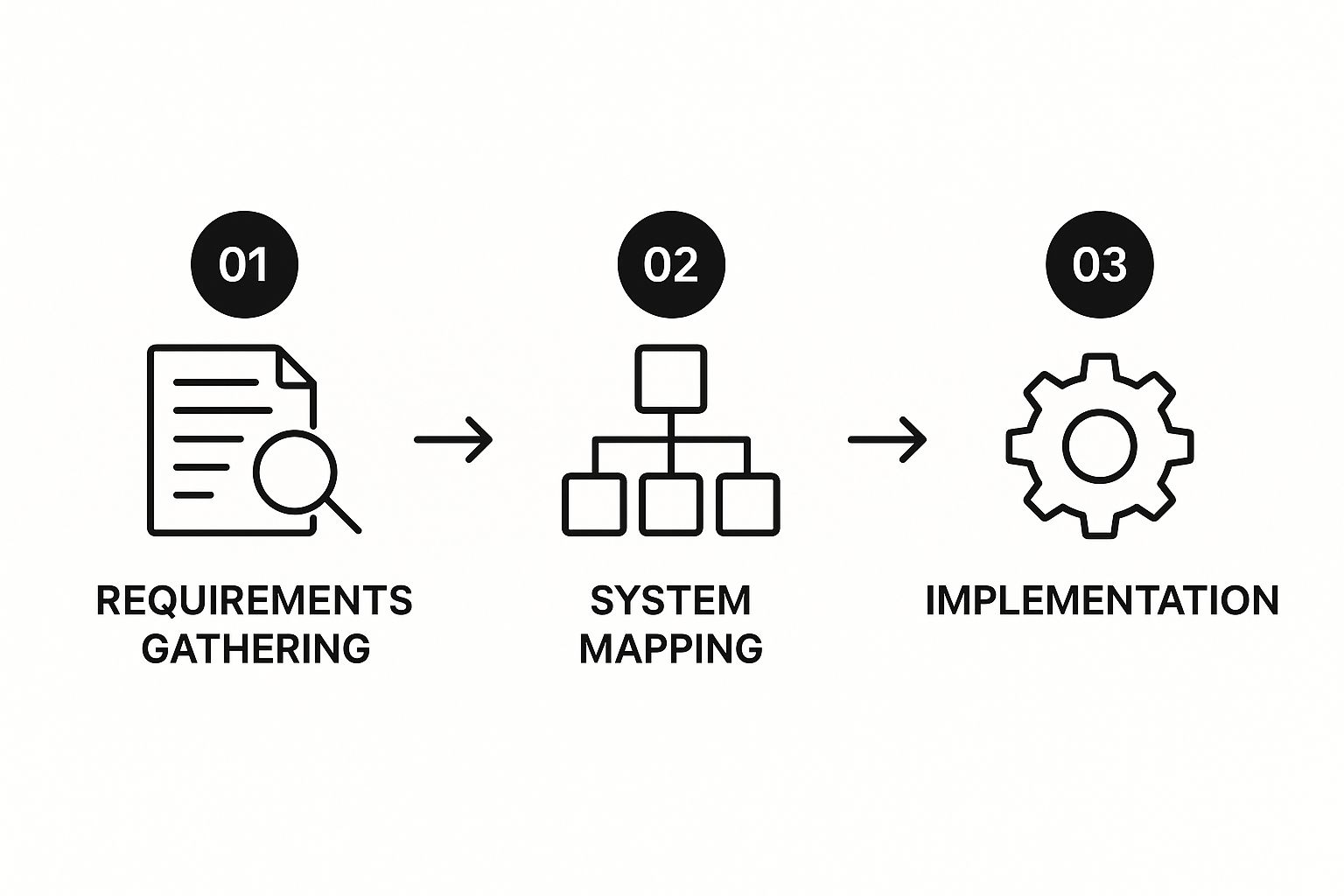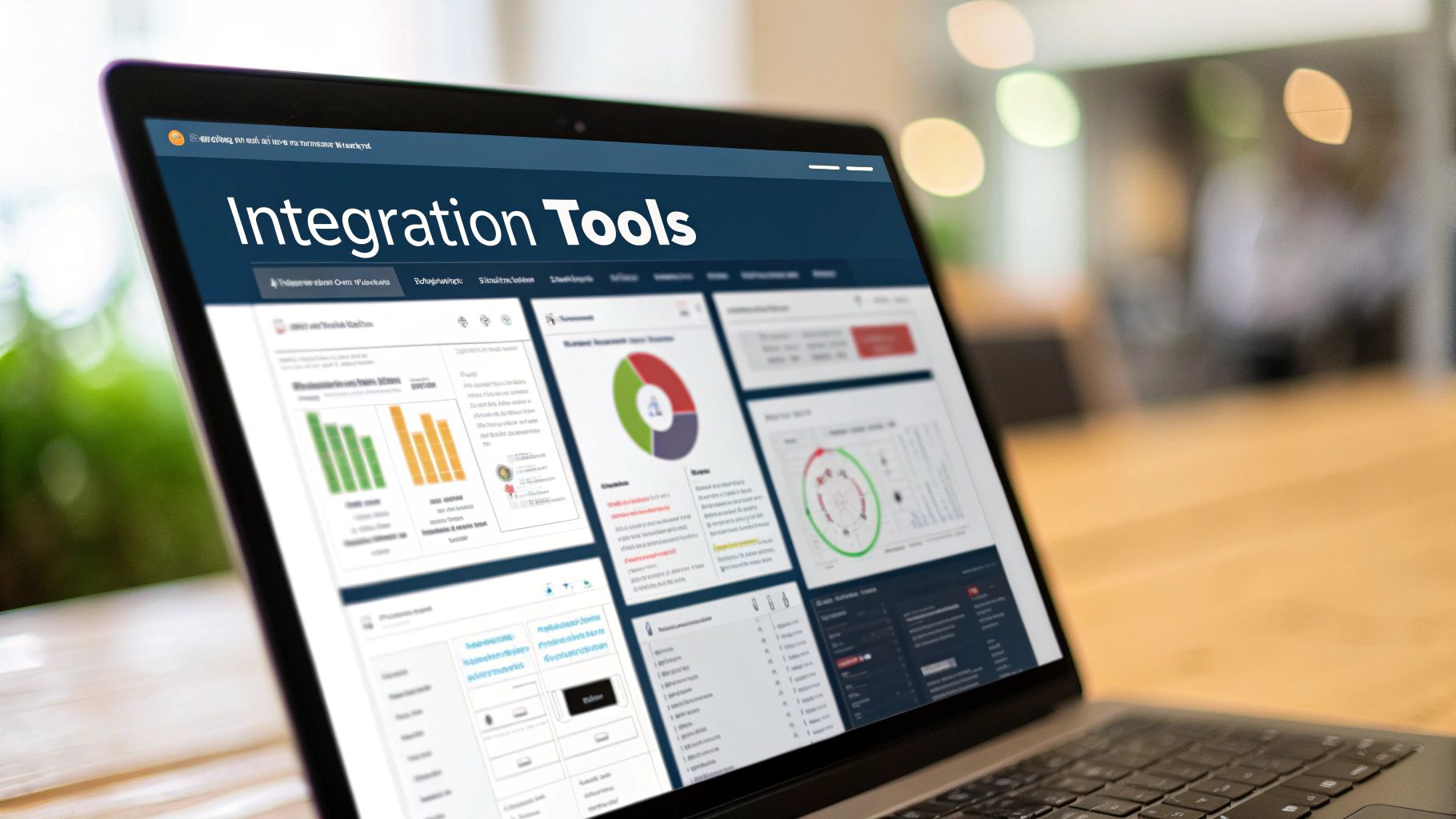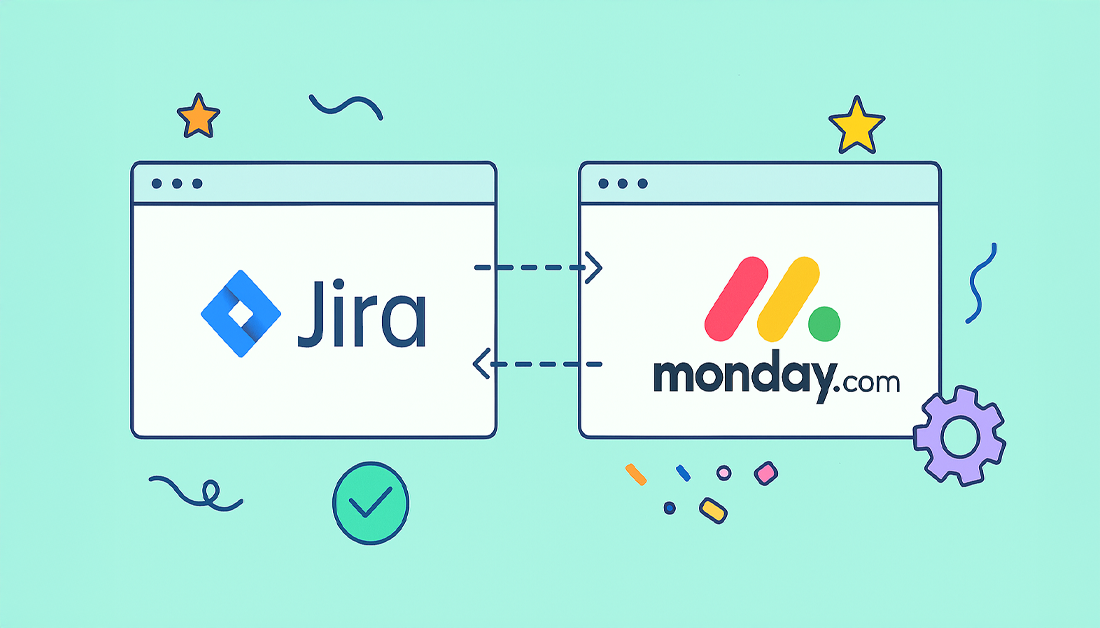Let’s be honest. Juggling projects with disconnected tools is a complete mess. It’s a world filled with endless “status update” meetings, developers who aren’t sure what the real priorities are, and managers stuck staring at outdated reports.
When one team lives in Jira, deep in the technical weeds, while another is managing timelines and client updates in monday.com, you’ve got a digital divide. This is exactly where productivity goes to die.

The real problem here is friction. Every single time a developer closes a ticket in Jira, someone has to remember to go and manually update the matching task in monday.com. This isn’t just boring work; it’s a massive point of failure. Information gets lost in translation, updates are delayed, and pretty soon, important strategic decisions are being made with old data.
I’ve seen it happen time and time again. The communication gap between the business side and the technical side widens until it becomes a chasm. To see what I mean, check out this quick breakdown of the common pain points.
Disconnected vs Integrated Workflow Pain Points
| Challenge in Disconnected Teams | How Integration Solves It |
|---|---|
| Manual, Repetitive Updates: Someone has to copy/paste status changes between systems. | Full Automation: Changes in Jira (like status or assignee) automatically update in monday.com, and vice-versa. |
| Data Silos & Misalignment: Business teams can’t see real-time developer progress. | A Single Source of Truth: High-level project boards in monday.com reflect the ground-level work happening in Jira. |
| Delayed Information: Managers make decisions based on old reports and guesswork. | Real-Time Visibility: Stakeholders get an instant, accurate view of project health without bugging the dev team. |
| Wasted “Status Update” Meetings: Teams spend hours just trying to get on the same page. | Transparent Workflows: Everyone can see progress in the tool they prefer, reducing the need for constant check-ins. |
This table really just scratches the surface. The day-to-day reality of a disconnected workflow is even more chaotic. But when you bridge that gap, everything changes.
A Smarter Way to Collaborate
A solid integration between these platforms isn’t just about connecting two apps; it’s about fundamentally changing how your teams work together.
Imagine a world where a marketing manager can see the live progress of a new software feature directly from their campaign board in monday.com—all because it’s synced with the development tasks in Jira. No more pinging engineers on Slack for an update.
This seamless flow of information creates powerful benefits:
- True Visibility: High-level stakeholders get a clear, executive-level view of project velocity without ever needing to log into Jira.
- Boosted Efficiency: You’re not just saving a few minutes. You’re giving hours back to your developers and project managers, letting them focus on what they were actually hired to do.
- Rock-Solid Alignment: Development sprints in Jira become directly tied to the business goals tracked in monday.com. Everyone is finally pulling in the same direction.
The ultimate goal is to build a workflow so smooth that no one even has to think about the tools. The right information just shows up where you need it, exactly when you need it.
This isn’t some niche desire, either. The project management software market is on a rocket ship, projected to hit an incredible $12.02 billion by 2030. This boom is driven by a simple fact: companies are desperate to improve how their teams collaborate. In fact, a staggering 82% of organizations already use these tools to boost their efficiency. You can discover more about these project management statistics and see just how critical this has become.
At the end of the day, integrating monday.com and Jira closes that painful communication gap between your technical and business teams. It turns a clunky, high-friction process into an automated, transparent, and genuinely effective system. You’re not just connecting software; you’re connecting people and aligning their best work toward a common goal.
Laying The Groundwork For A Smooth Integration
Diving headfirst into a project management integration without a plan is like building a house without a blueprint. It’s a surefire way to create rework, frustration, and a system nobody actually wants to use. Before you even think about clicking a single “connect” button, you need to do the strategic prep work.
This whole preparation phase is about mapping your workflows before they ever touch the software. The most critical question you have to answer is this: what information truly needs to flow between Jira and monday.com? Seriously. Not everything needs to sync, and deciding this upfront saves your teams from being buried in digital noise.
Define Your Single Source Of Truth
The goal here isn’t to duplicate everything everywhere. Far from it. You need to decide which platform “owns” which part of the process. For example, a common and effective setup I’ve seen is:
- Jira: Stays the system of record for all the deep technical stuff—bug logs, code-related comments, and detailed development tasks.
- monday.com: Becomes the high-level command center for project timelines, stakeholder updates, and tracking overall progress.
This clarity prevents so much confusion down the line. Your development team gets to work where they’re most effective, while managers get the 30,000-foot view they need without getting lost in the technical weeds. If you’re looking for more ideas on structuring these data flows, these workflow automation examples are a great resource for seeing how different triggers and actions can be combined.
Think of it this way: You’re not just connecting apps; you’re building a bridge. You need to know exactly what kind of traffic that bridge is designed to carry before you start pouring the concrete.
Aligning Permissions and People
Once you have your data flow mapped out, the next step is making sure the right people have the right access. This is where so many integrations fall flat right out of the gate.
In practical terms, this means the person setting up the integration needs Project Admin rights in the specific Jira projects you want to connect. At the same time, they’ll need to be an Admin or Owner of the relevant monday.com boards to build and manage the integration recipes.
Getting the permissions wrong is one of the most common reasons integrations fail. But the technical setup is only half the battle; it’s just as vital that the integration reflects how your teams actually work together. As you lay this foundation, it’s worth thinking about aligning project management with team culture to make sure the new, connected workflow feels natural and supportive, not forced.
Taking the time for this strategic planning honestly prevents over 90% of future headaches.
Connecting Monday.com and Jira Step by Step
Alright, let’s get down to business. You’ve done the strategic planning, and now it’s time to actually connect these two project management powerhouses. Forget the dense, technical manuals—this process is surprisingly straightforward when you know where to click. It all starts in the monday.com marketplace.
The very first move is to install the Jira integration app. Think of this as adding a new, specialized skill to your monday.com account. You’ll find it by navigating to your board, clicking the “Integrate” button (it looks like a little plug icon), and simply searching for “Jira.”
Here’s a look at what you’ll see.

This is the official Jira app tile, your gateway to bridging the two platforms. Once you click “Add to Board,” you’ll kick off the authentication dance. This just involves logging into your Atlassian account to give monday.com the green light to talk to Jira. It’s a secure handshake that makes everything else possible.
Building Your First Integration Recipe
With the app installed and authenticated, the real fun begins. The magic of this project management integration happens through “recipes.” A recipe is just a simple “if this, then that” automation rule you create. It’s incredibly intuitive.
For example, a classic starter recipe for a marketing team that works with a development team might be:
“When a Jira issue is created in Project X, create an item in our Marketing Launch board.”
Just like that, you’ve eliminated the need for a developer to remember to ping the marketing team about a new feature they’ve started working on. The information just appears, ready for the marketing manager to track.
One-Way vs. Two-Way Syncs: What’s the Right Call?
Now, you’ll face a key decision: should your sync be one-way or two-way?
- One-Way Sync: Information flows in a single direction. A new Jira issue might create a monday.com item, but any changes you make in monday.com won’t touch the original Jira issue. This is perfect for reporting and visibility without risking accidental changes to technical tasks.
- Two-Way Sync: Data flows in both directions. If you change the status of an item in monday.com to “Done,” the linked Jira issue automatically transitions to “Closed.” This creates a powerful, unified workflow but requires careful planning to avoid creating confusing automation loops.
For a deeper dive into the mechanics of setting up these automated workflows in Jira, you might find this guide on Jira workflow automation helpful.
Thinking through the integration flow visually often helps clarify whether a one-way or two-way sync is the better fit for your team’s needs.

The diagram really highlights how system mapping acts as the critical bridge between understanding your team’s needs and actually building the connection. Get this middle step right, and the final implementation will work exactly as you intended. Beyond specific tools, if you’re looking for comprehensive guidance on establishing smooth connections, check out this detailed a step-by-step guide to integrating with your existing workflow.
By starting with a simple, clear recipe, you can immediately show the value of the integration. From there, you can build out more complex automations that truly change how your teams collaborate.
Mastering Integration Recipes For Powerful Automation
The real magic of a solid project management integration isn’t just connecting two platforms—it’s what you build on top of that connection. This is where automation “recipes” come into play. They turn your manual, repetitive tasks into a self-sustaining workflow that practically runs itself.
Let’s move beyond the basics and craft some truly powerful automations.

The central idea here is dynamic field mapping. You can cook up recipes where an update to a specific field in Jira—like a due date, assignee, or priority level—is instantly mirrored in the corresponding monday.com item. This two-way communication keeps everyone aligned without a single manual update.
Practical Recipes For Your Teams
So, how does this look in the real world?
Imagine a product team that plans its sprints meticulously in Jira. They can set up a recipe that syncs key progress metrics from their active sprint directly into a high-level product roadmap on a monday.com board. Suddenly, stakeholders get a real-time view without ever having to leave their preferred tool. No more chasing down updates.
Or, think about a customer support team. They use a monday.com board to track user-submitted issues. With a simple recipe, they can change an item’s status to “Bug Confirmed,” and poof—the integration automatically creates a new, detailed bug report in the development team’s Jira backlog. The ticket gets escalated perfectly, without anyone having to copy and paste a single piece of information.
The goal is to build a system so seamless that the flow of information feels invisible. Tasks move, statuses update, and the right people are notified automatically. This frees up your team to focus on their actual work, not the administrative grind.
This kind of automation directly tackles a huge industry challenge. A remarkable 91% of project managers report facing persistent issues, and organizations waste around 12% of their resources because of poor project management. This often happens because teams, even agile ones, just don’t have good ways to connect their tools.
Advanced Field Mapping And Data Integrity
To make these automations really sing, you have to be deliberate about how you map your data. When you set up a recipe, you’ll be prompted to match Jira fields with monday.com columns. For this to work flawlessly, the data types must align. A “Number” field in Jira should map to a “Numbers” column in monday.com, for instance.
This is where a little planning goes a long way. Before you start building a web of complex recipes, take a moment to map out your most important data points. This attention to detail is a core component of successful customer data integration best practices.
Here’s a quick-glance table to help visualize some common field mappings:
| Jira Field | monday.com Column Type | Use Case Example |
|---|---|---|
| Assignee | Person | Keep the task owner synchronized across both platforms. |
| Due Date | Date | Ensure project timelines are identical in both tools. |
| Status | Status | Automatically reflect workflow progression from dev to business. |
| Story Points | Numbers | Allow managers to see workload and velocity from a high level. |
By mastering these recipes, you’re not just syncing data; you’re building an intelligent, automated system. You’re creating a smarter, more efficient way for your teams to collaborate, bridging that critical gap between technical execution and strategic oversight.
Best Practices and Common Mistakes to Avoid
https://www.youtube.com/embed/FgL7sMij-zo
Getting your tools connected is one thing. Making sure that shiny new integration doesn’t collapse into a confusing mess of notifications and conflicting data? That’s the real challenge. After setting up countless integrations, I’ve seen what separates a truly effective system from a digital headache.
The absolute first thing you need to do is establish crystal-clear rules of engagement. You have to decide which tool is the “source of truth” for specific information. For instance, a great setup keeps all the nitty-gritty technical discussions and bug-squashing debates right inside Jira comments. At the same time, monday.com becomes the hub for high-level status updates, overall timeline tracking, and communicating with stakeholders.
This simple separation of duties prevents chaos. Your developers can stay in their happy place, and your project managers get the big picture without having to wade through lines of code or technical jargon. It’s all about creating designated spaces for different kinds of work.
Avoid The Over-Automation Trap
One of the biggest mistakes I see teams make is getting a little too excited and trying to automate everything at once. This almost always leads to a firehose of notification spam, where every tiny change in one system pings everyone in the other. Before you know it, your team develops “notification blindness” and starts ignoring everything, which completely defeats the purpose.
My advice? Start small. Automate only the most critical, high-value updates first.
- Status Changes: Syncing a “Done” status in
monday.comto “Closed” in Jira is a fantastic, high-impact start. - New Item Creation: Automatically creating a task on a
monday.comboard when a new epic is created in Jira keeps teams aligned from the very beginning. - Assignee Syncing: This is a simple one, but it’s crucial. It ensures everyone knows who is responsible for what, no matter which platform they’re looking at.
The goal isn’t to create more noise; it’s to create meaningful signals. A great integration delivers the right information to the right person at the right time—and nothing more.
Prioritize Team Training and Data Integrity
Another common pitfall is just assuming your team will “get it.” You absolutely have to invest time in training everyone on the new, integrated workflow. Show them exactly how the tools talk to each other and, more importantly, what’s expected of them. Without this, old habits creep back in, and your beautiful integration will wither on the vine. This human element is a key part of successful agile processes, which you can learn more about in our guide to agile methodologies.
Maintaining data integrity is just as crucial, especially when you’re dealing with custom fields that don’t map perfectly between systems. The technical side of this is vital. For a deeper dive into keeping your connections solid, I highly recommend exploring these essential API integration best practices. This technical foundation is what supports your workflow rules and ensures data flows cleanly from one place to the other.
The importance of getting this right can’t be overstated. With over 85% of project managers juggling multiple projects at once, robust integration is no longer a luxury—it’s a necessity. Inefficiencies stack up, and it’s been shown that poor performance causes companies to lose nearly 10% of every dollar spent on projects. You can find more eye-opening data in these project management stats to guide your planning. By avoiding these common mistakes, you’ll ensure your integration is a powerful asset, not a frustrating liability.
Frequently Asked Questions

Jumping into a new integration always surfaces a few questions. It’s natural. So, let’s walk through some of the most common things people ask about connecting monday.com and Jira. This will help you get your setup dialed in just right.
Can I Sync Custom Fields From Jira To Monday.com?
Yes, absolutely! This is one of the most powerful parts of the integration. When you’re setting up an integration recipe, you can map most of your team’s custom Jira fields straight to columns on a monday.com board.
This works great for crucial data like ‘Story Points,’ ‘Epic Links,’ or any other unique fields that drive your team’s workflow. The secret to getting this right is to match the column type in monday.com to the field type in Jira. Think number fields to Numbers columns, text fields to Text columns, and so on. A little planning here goes a long way.
A common hiccup we see is people trying to sync a complex Jira field into a simple monday.com column. Always double-check that the field types are compatible before you save the recipe. This one small step prevents the vast majority of sync errors and keeps everything humming along.
What Happens If The Integration Fails To Sync?
First off, don’t panic. Sync failures happen, and monday.com has you covered with built-in notifications. You can usually find a pretty detailed error log right in your board’s integration center, which will point you straight to the problem.
More often than not, the culprit is something simple. Maybe someone changed a permission setting in Jira, a user’s account was deactivated, or a project’s workflow rules were updated. The fix is typically just re-authenticating the connection or tweaking the recipe to match the new settings in Jira.
Does The Integration Work With Jira Cloud And Server?
It sure does. The integration is built to work with both Jira Cloud and on-premise Jira Server/Data Center environments.
The setup for Jira Server is a bit different, as you might expect. It involves creating what’s called an “application link” inside your Jira instance. This establishes a secure, trusted channel for monday.com to talk to your server. The official documentation has a solid walkthrough for getting this server-side configuration done.
How Much Does The Jira Integration Cost?
The Jira integration app itself is free to install from the monday.com marketplace. The real cost is indirect—it’s tied to your monday.com plan’s limit on automations and integrations.
Here’s how it works: each time one of your integration recipes runs successfully, it uses one “action” from your plan’s monthly allowance. This means the cost really just depends on your subscription tier and how heavily you rely on the automations. It’s a good idea to keep an eye on your usage, especially if you’re building out a lot of complex, multi-step workflows.
For agile teams, refining these kinds of processes is everything. Using a Scrum retrospective template can be a great way to identify where your team can improve and how integrations can better support your flow.
Ready to bridge the gap between your project planning and technical execution? resolution Reichert Network Solutions GmbH offers the definitive integration to unify your teams. Embed monday.com for Jira today and build a truly seamless workflow.
